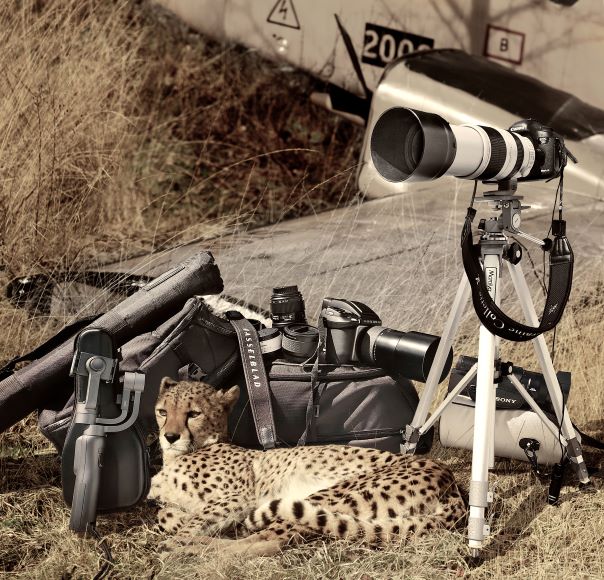
Dear reader, I am Cheraine Collette, a professional artist based in Otterlo, the Netherlands.
I studied photography at the University of Applied Photography (NL) from 2013-2015. During this time, I worked on various projects, enhancing my photography, painting, and photo editing skills.
My debut was with my ‘Marvels’ series at the International Photography Awards (IPA) in 2019, which was honored with first place in fine art.
Since then, my work has received over seventy Golden and Platinum Awards, multiple first-place honors, and recognition as the winner of prestigious international awards.
Among them are two Golden Pangea Trophies (SIPA), two first-place awards from the IPA, and a Golden Medal from the Photo Society of America (PSA).
After a few years, in 2021, my work is represented by established international galleries and has been showcased at various art fairs, biennials, solo shows, and group shows.
My work has been published by National Geographic Traveler China twice in 2020 and featured by outlets such as Forbes, My Modern Met, National Geographic, and The Wallace Collection Museum.
My artistic style blends fine art photography with digital painting. I explore themes centered on the beauty and fragility of nature, humanity’s treasures, and the harmony between them.
This inspires me to explore a broad and diverse spectrum with an interplay of different subjects, like my ‘Limitless’ series.
How would humankind be, and have been, without the natural treasures that make us dream and exceed beyond our limits?
Would we have dreamt of flying without the example of birds?
Would we have dreamt of speed beyond the fastest cheetah or horses?
Would we have searched in the depths beyond the limit of the whales?
Nature is the infinite source of inspiration.
Through my photographic paintings, I like to share our world’s beauty and encourage to cherish, preserve, and protect the natural splendor and human wonders that make our planet so unique for future generations.
I have two cameras to take all the photos I need as raw material for my photographic paintings.
Hasselblad H5D – for portraits, still life, skies, architecture, palace interiors, and occasionally wildlife, I prefer the Hasselblad H5D camera because it captures all the subtle nuances of color and detail so beautifully.
Hasselblad HC 150mm f/3.2 lens – my H5D is equipped with this lens, and this field of view works perfectly.
Hasselblad converter H1.7x – the teleconverters are helpful for me when photographing wildlife, allowing me to get closer to the subject if necessary.
I prefer this mainly because the combined weight of the teleconverter and lens is lighter than a 600mm lens.
This combination gives me a 640mm field of view in a hand-held package; this allows me to be as mobile as possible and quickly change my angle or position to capture the most varied poses from the animals, as it is often a matter of seconds or a few minutes.
Canon Eos 5D Mark III – I prefer my Canon for low-light photography, including palace interiors and museums, wildlife in high or low light, and subjects with high speeds.
After trying out a lot of different lenses over the years, I have found the perfect range to capture everything I need for my photographic paintings. I tend to have a small, efficient selection of lenses that I take with me for travel.
I have my Canon 5D equipped with two different lenses:
Canon EF 24-70mm Ultrasonic f/2.8L II USM – I use for any subject that needs a wider field of view or is in low lighting conditions.
Canon EF 100-400mm f/4.5-5.6L IS II USM – I use to capture wildlife in great detail while staying at a considerable distance.
Canon Extender EF 1.4 x III – as mentioned above for the Hasselblad converter.
Oppo Find X5 Pro – I have my Oppo equipped with a Hasselblad lens, and it’s often used to shoot content that I can use later to post on some of my social media.
Sometimes, I mount it on a DJI Osmo Mobile Gimbal when I want ultra-stabilized and super-smooth footage on location.
Sony Handycam FDR-AX100 – I use this one to capture short, detailed, close-up videos, mainly of wildlife. I carry the whole thing in my two Case Logic camera bags.
Vintage tripod Mamiya model 150 – I can usually shoot handheld, but I like to use the tripod on some low-light occasions.
This Mamiya turned out to be a great vintage find and has become indispensable; it’s incredible how quick it is to set up because of the unique handles on each foot.
It’s at least three times faster than setting up my Manfrotto Tripod, which I rarely use anymore.
To create one of my photographic paintings, I rely solely on my own photographs; therefore, I travel to many locations to capture the various elements I puzzle and blend on my digital canvas, the Wacom Cintiq Pro 24.
I use Adobe Photoshop, Indesign, and Illustrator editing software and apply traditional painting techniques.
Some pieces are built from five hundred to eight hundred layers containing raw photographs, hand-painted details and masks, highlights and shadows, and color corrections.
But before that work begins, I make my selection in Adobe Bridge.
I have essentially a triple screen set up for monitoring with the Eizo ColorEdge CG2700X and the Eizo CX271 along with the Wacom Cintiq Pro for a multiscreen workflow, which helps me a great deal in being more efficient.
The Eizo monitors are a must for me to view everything in their true colors, which helps me get the perfect color match for the final print with my master printers.
I could probably manage with just one screen, but it makes a difference in convenience.
I like to use Adobe After Effects and Premiere Pro for video footage.
I hope this has given you an insight into my creative practice and passion and that you will follow your passion for photography and art.
Sincerely.
Credit : Source Post






